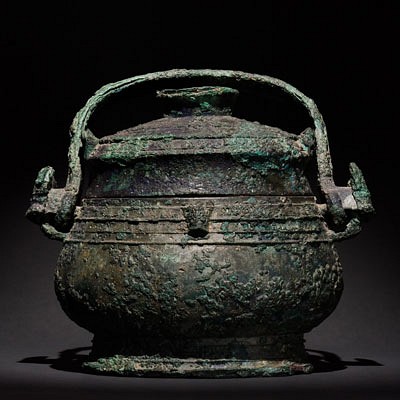ANCIENT BACTRIAN BLACK STONE JAR WITH LID
Lot 72
Categories
Estimate:
GBP£600 - GBP£900
$750 - $1,125
Absentee vs Live bid
Two ways to bid:
- Leave a max absentee bid and the platform will bid on your behalf up to your maximum bid during the live auction.
- Bid live during the auction and your bids will be submitted real-time to the auctioneer.
Bid Increments
| Price | Bid Increment |
|---|---|
| GBP£0 | GBP£1 |
| GBP£10 | GBP£5 |
| GBP£100 | GBP£10 |
| GBP£200 | GBP£20 |
| GBP£500 | GBP£50 |
| GBP£1,000 | GBP£100 |
| GBP£2,000 | GBP£200 |
| GBP£5,000 | GBP£500 |
| GBP£10,000 | GBP£1,000 |
| GBP£20,000 | GBP£2,000 |
About Auction
By Apollo Art Auctions
May 2, 2021
Set Reminder
2021-05-02 08:00:00
2021-05-02 08:00:00
America/New_York
Bidsquare
Bidsquare : The Art of Ancient Asia
https://www.bidsquare.com/auctions/apollo-art-auctions/the-art-of-ancient-asia-6802
From TL Tested Chinese Terracotta to exquisitely carved Gandharan statues; and Greco-Bactrian Silver and Sassanian Bronze. Find the ancient artefacts of the Indus Valley and travel through time to the Crusader Era Seljuk Terracotta. Apollo Art Auctions enquiries@apolloauctions.com
From TL Tested Chinese Terracotta to exquisitely carved Gandharan statues; and Greco-Bactrian Silver and Sassanian Bronze. Find the ancient artefacts of the Indus Valley and travel through time to the Crusader Era Seljuk Terracotta. Apollo Art Auctions enquiries@apolloauctions.com
- Lot Description
C. 3000-2000 BC. Bactrian. A large and impressive stone jar with a lid. The vessel has a round flat body and the lid shows traces of incisions, probably intended as a decorative element by the maker. Bactrian vessels were commonly made from this grey stone, made of a type of stone widely available in Oman that was traded north through Arabia, the Gulf, Iran, Baluchistan, and Pakistan. Archaeologists believe that these objects were traded not just as vessels, but for what they held. This piece relates to an ancient culture referred to both as the Bactria-Margiana Archaeological Complex (BCAM) or as the Oxus Civilisation. The Bactria-Margiana culture spread across an area encompassing the modern nations of Turkmenistan, Tajikistan, Uzbekistan and Northern Afghanistan. Flourishing between about 2100 and 1700 BC, it was contemporary with the European Bronze Age, and was characterised by monumental architecture, social complexity and extremely distinctive cultural artefacts that vanish from the record a few centuries after they first appear. Pictographs on seals have been argued to indicate an independently-developed writing system. It was one of many economic and social entities in the vicinity, and was a powerful country due to the exceptional fertility and wealth of its agricultural lands. This in turn gave rise to a complex and multifaceted set of societies with specialist craftsmen who produced luxury materials such as this for the ruling and aristocratic elites. Trade appears to have been important, as Bactrian artefacts appear all over the Persian Gulf as well as in the Iranian Plateau and the Indus Valley. For this reason, the area was fought over from deep prehistory until the Mediaeval period, by the armies of Asia Minor, Greece (Macedonia), India and the Arab States, amongst others. Through local stone carvers inhabiting the regions of Margiana and Bactria experienced no shortage in material; the main raw material was soft steatite or a dark soapstone, but also various kinds of marble and white-veined alabaster. The main source for these stones, including semi- precious lapis-lazuli, was in Bactria, at Badakhshan in north-western Afghanistan, which provided material not only for the Bactrian and Margian carvers but also farther to the west into Mesopotamia, for the Assyrian kings Provenance: From an old British collection of Asian Art formed in the 1990 on the UK and European art market. Size: L:80mm / W:145mm ; 800g
- Shipping Info
-
We offer in-house packing and international shipping at discounted rates.
-
- Buyer's Premium



 EUR
EUR CAD
CAD AUD
AUD GBP
GBP MXN
MXN HKD
HKD CNY
CNY MYR
MYR SEK
SEK SGD
SGD CHF
CHF THB
THB


















